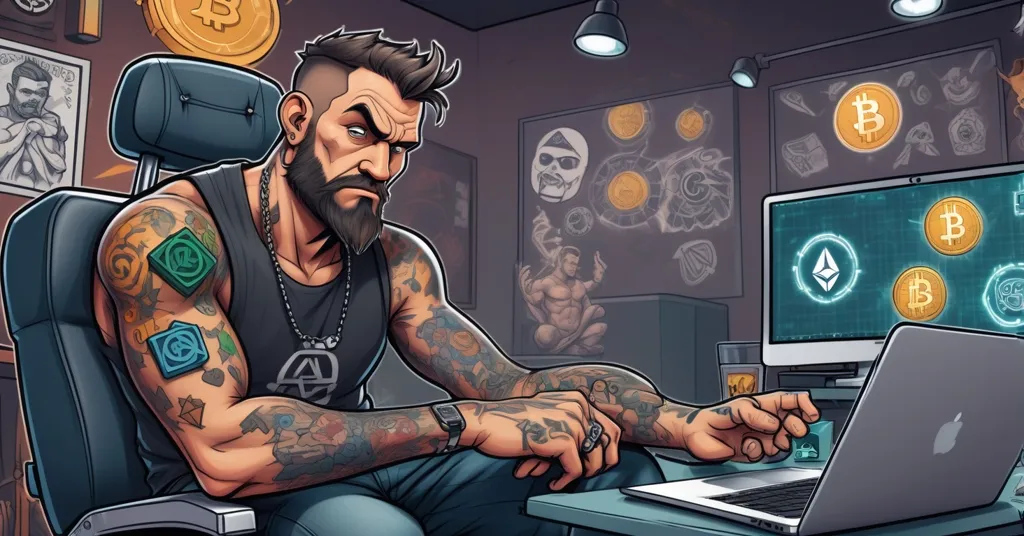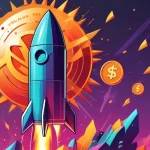Australian Man Attempts 700 ‘Pump.fun’ Tattoos for Guinness Record and Crypto Hype

Australian Man Zachary Gollan Livestreams Audacious Bid for Guinness Record with 700 ‘Pump.fun’ Tattoos in Crypto Stunt
Zachary Gollan, a 27-year-old from Sydney, Australia, is pushing the boundaries of personal branding and cryptocurrency promotion by attempting to tattoo the name of Solana’s memecoin launchpad “Pump.fun” on his body 700 times. Known online as Donnie Darko, Gollan is chasing a Guinness World Record while livestreaming the process on X, blending body art with blockchain hype to spotlight both the platform and his own Solana-based meme token, PUMPINK.
- Record Chase: Gollan has inked “Pump.fun” 415 times, needing 285 more to beat the current record of 667 tattoos of the same name by Mark Owens from the UK.
- Crypto Marketing: This stunt doubles as viral promotion for Pump.fun and his volatile token PUMPINK, which has crashed 73% from its peak.
- Personal Pivot: A former tattoo artist barred from the industry due to past biker gang ties, Gollan aims to reinvent himself as a crypto-focused content creator.
From Biker to Blockchain: Gollan’s Redemption Story
Gollan’s journey is anything but ordinary. Once a practicing tattoo artist, his career was derailed by legal restrictions tied to past affiliations with a biker gang, classified as a criminal organization under Australian law. In New South Wales, statutes like the Crimes (Criminal Organisations Control) Act 2012 often prohibit individuals with such connections from owning or operating businesses such as tattoo parlors. Now working as a removalist, Gollan is determined to carve out a new path in the digital realm, targeting the crypto community with a bold vision of a virtual tattoo studio. He dreams of designing artwork tailored for blockchain projects—think custom ink as promotional tools for tokens or NFTs.
“I want to utilize my skills as a tattoo artist to build a virtual tattoo studio business online. A place where I can design and showcase tattoo designs and artworks tailored for the crypto community, where they can use my pieces as advertisements or promotions for their projects,” Gollan shared.
His record attempt isn’t just about reclaiming a professional identity; it’s a calculated play in the attention economy that defines much of crypto culture. By plastering “Pump.fun” across his skin hundreds of times, Gollan is banking on curiosity as a marketing tool, hoping even fleeting encounters will spark interest in the Solana platform Pump.fun. Whether it’s a nurse during a hospital visit or a cop during a hypothetical arrest, he’s betting on the shock value of his ink to drive searches and conversations.
“Say I’m in the hospital and I get a blood test, the nurses will see the tattoos, and even if they don’t ask, their curiosity will wonder why I have Pump.fun hundreds of times on my arm. Same with if I got arrested, the police will see and ask, or just go home and search,” Gollan mused.
Pump.fun: Innovation or Scam Haven on Solana?
For those new to the space, Pump.fun is a Solana-based memecoin launchpad that lets anyone create a token with minimal hassle. Solana itself is a high-speed blockchain, capable of handling up to 50,000 transactions per second with fees often under a cent—think of it as the express lane compared to Bitcoin’s slower, pricier transfers or Ethereum’s still-costly gas fees even after upgrades. This makes Solana a playground for speculative projects like memecoins, tokens often built on memes or hype rather than utility. Pump.fun leverages a bonding curve mechanism—a pricing system where costs rise as more people buy in—to reduce the risk of rug pulls, scams where creators hype a token then vanish with investors’ funds.
But let’s not sugarcoat it: Pump.fun’s reputation is far from spotless. While it democratizes token creation, communities on platforms like Reddit’s r/solana are split. Some praise its design for curbing outright scams, but others call it a glorified casino, pointing to countless low-quality or fraudulent tokens launched daily, as discussed in various Reddit threads on Pump.fun’s legitimacy. Data backs the skeptics—over 90% of memecoins bleed out within weeks, per CoinGecko reports. Gollan’s endorsement via permanent ink might turn heads, but it doesn’t erase the platform’s baggage. Is this a genuine boost for decentralized innovation, or just another hype machine fueling bagholders’ tears?
PUMPINK: Hype-Driven Bust or Community Play?
Speaking of hype, Gollan recently launched his own Solana-based meme token, PUMPINK, tying it to his tattoo journey and personal brand. Less than a week into its existence, PUMPINK soared to a market cap of $412,150 before cratering 73% to around $108,000, trading at a measly 0.0000006251 SOL at last check. This kind of volatility is the norm in the memecoin swamp—most of these tokens are pure FOMO traps, leaving latecomers holding worthless digital dust. Frankly, it’s garbage-tier behavior that preys on the naive, and we’ve got zero patience for it. Wake up, degens: these aren’t investments; they’re lottery tickets with worse odds.
Still, Gollan sees PUMPINK as more than a quick cash grab. It’s part of his broader strategy to build a crypto identity, with plans to break additional records under the token’s banner—like most hashtag tattoos (#PUMPINK) or most tattoos of a cartoon character linked to memecoins or NFTs. He’s aiming for “at least five or six records before the end of the year.” Admirable grit, sure, but with PUMPINK already floundering as seen in PUMPINK’s market cap drop analysis, one has to wonder if this is sustainable community-building or just another flash of viral desperation.
“I want to try to break at least five or six records before the end of the year,” Gollan declared.
Skin-Deep Risks: Health and Ethical Dilemmas
Make no mistake—tattooing your body 700 times with anything, let alone a crypto platform’s name, is unhinged, even by the Wild West standards of blockchain stunts. Beyond the sheer audacity, there are real health risks at play. Repeated tattoo sessions over short periods can lead to infections, ink toxicity, or long-term skin damage, according to tattoo industry standards and medical experts. The human skin isn’t a limitless canvas—push it too far, and it rebels. Gollan’s livestreaming every prick on X for transparency and clout, as covered in reports of his tattoo livestream, but at what cost to his body?
Then there’s the ethical side. Using permanent body modification for speculative gain or marketing raises red flags. Is this empowerment through personal expression and decentralization, or a cautionary tale of chasing internet fame at any price? Gollan’s past legal barriers paint a redemption arc—shut out of traditional tattooing, he’s turning to crypto for a second chance. But turning your arm into a Solana billboard feels like a gamble with more downside than a memecoin crash. Hope he doesn’t need a ‘delete’ button if PUMPINK hits zero.
Crypto’s Attention Addiction: A Broader Trend
Zooming out, Gollan’s stunt is a microcosm of the chaotic brilliance and inherent recklessness in the crypto space. It embodies the rebellious spirit of blockchain—disrupting norms, promoting decentralized platforms like Pump.fun through sheer audacity. Yet it also mirrors a troubling trend of extreme marketing tactics, from naming rights to outrageous giveaways, where attention is the real currency. Historical data shows the fallout: most hype-driven tokens fail post-launch, leaving investors burned while stunts like this grab headlines. Does turning your skin into an ad make normies trust crypto, or run screaming from the circus? For deeper insights, check out discussions on risks of memecoin platforms.
Compare this to Bitcoin, the gold standard of decentralization. While Solana’s memecoin casino showcases the wilder, riskier side of blockchain tech, Bitcoin’s ethos of sound money and privacy stands in stark contrast to the speculative madness. Still, there’s a place for both—altcoins like those on Solana fill niches Bitcoin doesn’t touch, driving innovation even if 90% of it is trash. If regulators catch wind of stunts like Gollan’s, don’t be surprised if they crack down harder on memecoin nonsense. Frankly, good riddance to most of it. For more on this, explore analyses of Solana memecoin trends and risks.
The Bigger Picture: Shaping Crypto’s Future
As Gollan needles his way toward 700 tattoos, one wonders if this is true freedom or a permanent scar from chasing crypto clout. His saga reflects the ethos of effective accelerationism—pushing boundaries to speed up adoption of decentralized tech—but it also begs the question of sustainability. Will viral antics like this normalize blockchain for the masses, or taint it as a playground for the reckless? Perhaps the real test is whether platforms like Solana and tools like Pump.fun can evolve beyond hype to deliver lasting value. Until then, Gollan’s ink, detailed in coverage of his record attempt progress, is both a spectacle and a warning: in crypto, attention may be currency, but the price of earning it can be steep.
Key Takeaways and Questions for Crypto Enthusiasts
- What’s behind Zachary Gollan’s extreme tattoo record attempt?
He’s targeting a Guinness World Record with 700 “Pump.fun” tattoos to promote the Solana memecoin launchpad and build his personal brand in the crypto space. - How does Gollan’s past shape his current path?
Legal restrictions from past biker gang ties in Australia block him from traditional tattoo work, driving him toward online content creation and blockchain projects. - What’s the story with PUMPINK, and is it significant?
Gollan’s meme token peaked at $412,150 but tanked 73% to $108,000, exposing the brutal volatility and speculative risks of memecoins that often hurt investors. - Does Pump.fun deserve the spotlight Gollan’s giving it?
While it lowers entry barriers for token creation on Solana, widespread skepticism about scam projects on the platform suggests it’s far from a sure bet. - What health and ethical risks come with this stunt?
Extensive tattooing poses dangers like infection or skin damage, while using permanent ink for speculative marketing raises questions about personal cost versus gain. - How does this fit into broader crypto marketing trends?
It highlights the attention economy’s extremes, where viral stunts can overshadow risks like token crashes, pushing us to weigh hype against sustainable adoption. - Does this help or hurt crypto’s mainstream image?
Such antics might grab eyes but risk painting crypto as reckless, potentially fueling regulatory crackdowns while testing the limits of decentralized freedom.



